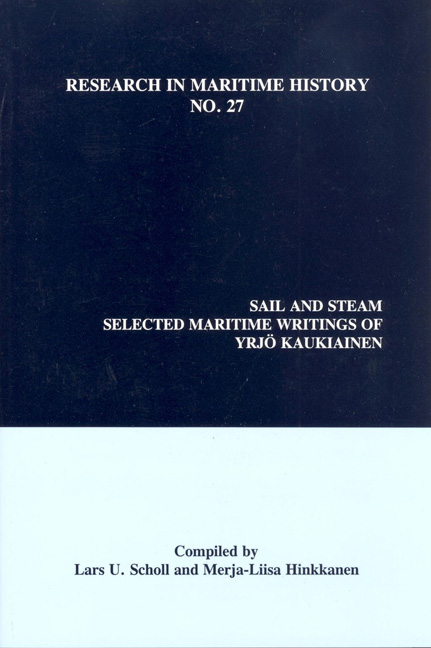Book contents
- Frontmatter
- Frontispiece
- Table of Contents
- Acknowledgements
- “Yrjö Kaukiainen: A Tribute on the Occasion of his Forthcoming Retirement as Professor of Maritime History at the University of Helsinki”
- “Yrjö Kaukiainen: A Man of the Sea”
- “Yrjö Kaukiainen and the Development of Maritime Economic History”
- “Finnish Sailors, 1750-1870”
- “Finnish and International Maritime Labour in the Age of Sail: Was There a Market?”
- “Five Years before the Mast: Observations on the Conditions of Maritime Labour in Finland and Elsewhere”
- “The Maritime Labour Market: Skill and Experience as Factors of Demand and Supply”
- “Owners and Masters: Management and Managerial Skills in the Finnish Ocean-Going Merchant Fleet, c. 1840-1880”
- “From Low-Cost to High-Cost Shipping: Finnish Maritime Labour Costs after the Second World War”
- “The Modernization of Finnish Coastal Shipping and Railway Competition c. 1830-1913”
- “British Timber Imports and Finnish Shipping 1860-1910”
- “Baltic Timber-Trade under Sail: An Example of the Persistence of Old Techniques”
- “Coal and Canvas: Aspects of the Competition between Steam and Sail, c. 1870-1914”
- “Dutch Shipping and the Swedish Navigation Act (1724). A Case Study”
- “Seamen Ashore: Port Visits of Late Nineteenth-Century Finnish Sailors”
- “Wreck-plundering by East Finnish Coastal People - Criminal Tradition or Popular Culture?”
- “From Days and Knots to Pounds and Dollars: Some Problems in the Study of the Economics of Late Nineteenth Century Merchant Shipping”
- “Tons and Tonnages: Ship Measurement and Shipping Statistics, c. 1870-1980”
- “International Freight Markets in the 1830s and 1840s: The Experience of a Major Finnish Shipowner”
- “Shrinking the World: Improvements in the Speed of Information Transmission, c. 1820-1870”
- “Yrjö Kaukiainen: A Maritime Bibliography”
“Yrjö Kaukiainen: A Man of the Sea”
- Frontmatter
- Frontispiece
- Table of Contents
- Acknowledgements
- “Yrjö Kaukiainen: A Tribute on the Occasion of his Forthcoming Retirement as Professor of Maritime History at the University of Helsinki”
- “Yrjö Kaukiainen: A Man of the Sea”
- “Yrjö Kaukiainen and the Development of Maritime Economic History”
- “Finnish Sailors, 1750-1870”
- “Finnish and International Maritime Labour in the Age of Sail: Was There a Market?”
- “Five Years before the Mast: Observations on the Conditions of Maritime Labour in Finland and Elsewhere”
- “The Maritime Labour Market: Skill and Experience as Factors of Demand and Supply”
- “Owners and Masters: Management and Managerial Skills in the Finnish Ocean-Going Merchant Fleet, c. 1840-1880”
- “From Low-Cost to High-Cost Shipping: Finnish Maritime Labour Costs after the Second World War”
- “The Modernization of Finnish Coastal Shipping and Railway Competition c. 1830-1913”
- “British Timber Imports and Finnish Shipping 1860-1910”
- “Baltic Timber-Trade under Sail: An Example of the Persistence of Old Techniques”
- “Coal and Canvas: Aspects of the Competition between Steam and Sail, c. 1870-1914”
- “Dutch Shipping and the Swedish Navigation Act (1724). A Case Study”
- “Seamen Ashore: Port Visits of Late Nineteenth-Century Finnish Sailors”
- “Wreck-plundering by East Finnish Coastal People - Criminal Tradition or Popular Culture?”
- “From Days and Knots to Pounds and Dollars: Some Problems in the Study of the Economics of Late Nineteenth Century Merchant Shipping”
- “Tons and Tonnages: Ship Measurement and Shipping Statistics, c. 1870-1980”
- “International Freight Markets in the 1830s and 1840s: The Experience of a Major Finnish Shipowner”
- “Shrinking the World: Improvements in the Speed of Information Transmission, c. 1820-1870”
- “Yrjö Kaukiainen: A Maritime Bibliography”
Summary
Sometimes a certain affinity or point of identification exists between a scholar and a field of research. What sort of a ship master would Yrjö Kaukiainen be, for instance? If we look for suitable similes from maritime history, he would definitely be a nineteenth-century Finnish ship master, a skilled professional who has paced the poop decks of a variety of vessels during his long career at sea.
This is not merely because Yrjö actually is an experienced sailor who bought a boat of his own in the late 1960s and continues to sail to this day. His Helsinki colleagues of the sixties remember that Captain Kaukiainen's nautical skills were top-class and evenings at sea very pleasant - unless, that is, the Captain got carried away and began to sing. Whether this is just a piece of seamen's lore, or whether Yrjö's sonant powers really are unforgettable, is something for which I cannot vouch.
Nor do I see Yrjö as a ship master just because he hails from a maritime lineage, though of course that was precisely the background nineteenth-century Finnish ship masters almost always had. Observant readers of Yrjö's 1992 article “Five Years Before the Mast” may have noticed a small item of personal information - that his family in the 1930s owned a coastal steamer in the strongly maritime region of Koivisto, some distance south from Viipuri on the coast of the Carelian isthmus. On board this steamer one of his uncles was master and another was chief engineer, with two other relatives hired as additional hands.
Characteristically, this bit of personal unveiling took place in a footnote, for Yrjö is basically a very private man - again, just as nineteenth-century ship masters used to be. Nevertheless, I can reveal that Captain Kaukiainen's birth in April 1940 actually took place at an entirely land-locked location several hundred kilometres out of the sight of the sea due to the exigencies of Finnish history during the Second World War. And indeed, it has been Finnish history - or, more precisely, Finland's place in the wider world - which has occupied most of Yrjö's scholarly powers ever since, with the Baltic being very much his own sea.
- Type
- Chapter
- Information
- Sail and SteamSelected Maritime Writings of Yrjö Kaukiainen, pp. xvii - xxPublisher: Liverpool University PressPrint publication year: 2004

